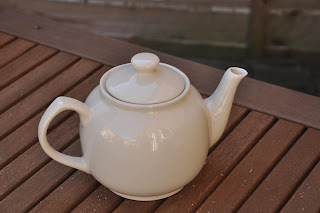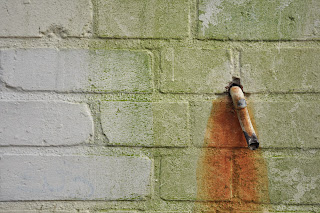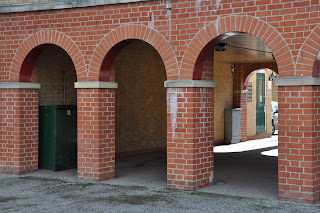For this exercise I had to find a scene with average brightness. I then had to find the exposure setting where the highlight clipping warning starts to appear. This was at f/13 1/80s ISO 200.
The second shot I had to increase the exposure by one stop which I did by adjusting the shutter speed. The exposure settings for this were f/13 1/40s.
For the next three shots I had to decrease the exposure by one stop for each exposure.
Below are the images:
1. f/13 1/80s
This image was shot with the highlights warning displayed in the left background of the shot.
This image was shot close to the camera's meter reading for an average exposure.
You can see in the crop of the highlights area that the sky is a very weak blue and the brick work in the house is as good as blown out. It is difficult to see a clear and defined edge to the building and the sky.

2. One stop over-exposed f/13 1/40s
The highlight warning was flashing for the entire sky and on the roofs of the buildings. From the crop we can see that the top of the building and the sky is completely blown out and we've almost completely lost the areas of visual communication.
We can see from the different colours in the brickwork that there is a slight break in the edge between nearly white and total white.
A colour cast can be see on the branches of the trees that overlap the top of the building.
The colours are very weak throughout the image.
The red car in the background is washed out too.

3.One stop under-exposed f/131/160s
The highlight warning was not flashing for this exposure. The colours are stronger, more saturated. The building is more defined although not true to how it appeared in reality. The sky is also paler that in reality but it is not blown out. They are certainly weaker that I would want.
4. Two stops under-exposed f/13 1/320s
The colour of the sky is more saturated and more true to life. However, the foreground of the image is a little too dark now. The colours of the bricks are stronger too and the edges are more visible and sharper.
The tree is holding its colour and is not affected by the highlighted area in the image.
5. Three stops over-exposed f/13 1/640s
This image is very dark but is possibly the one that captures the highlighted area best. The colours are more true to life for the bricks and the edges are clean and sharp. This comes at a sacrifice as much of the shadow detail is lost in the foreground and to the right. The boat on the water is hardly recognisable.
As the first two images are the only ones that had a highlight clipping warning I am going to experiment with these in Lightroom using the 'Recovery' slider. I could use the exposure slider to make adjustments to the image but I relied solely on the Recovery option.
Although the highlight clipping warning lessens as you move the slider to the right it does not alter the rest of the image. For the second image it makes for a very washed out picture. It is clear that the image needs more adjustment other than recovery alone.
The highlight area in image 1. Moving the recovery slider restored some of the highlights but there was still a washed out look to them on closer inspection.
In image 2 the cropped area had lost nearly all detail.
Before any adjustments
After moving the slider all the way. We have lost some of the saturation in the colours that weren't too badly affected. You can see this from the shadow on the wall and the tree.
My compromise in this situation was to use image one where the highlights were less clipped and to move the recovery slightly till these areas were reduced. Not as much of the image is affected.
Image 3 would have been the image I would have selected from this series as I exposed for the sky and no highlight warning was visible. The image has also kept much of the shadow detail in the foreground including the reflections of the building in the water. It has also retained the colours in the image pretty realistically.





















































